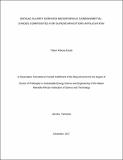| dc.description.abstract | With the increasing utilities of intermittent renewable energies, hybrid electric vehicles and portable
electronic devices, supercapacitors have been identified as one of the solution for energy storage
since they can deliver high power. The main drawback of the supercapacitors is low energy densities
which can be increased either by synthesizing nanostructured porous materials or improving the
voltage window of the electrolyte. In this study the mesoporous carbons were synthesized from
biogas slurry by varying the carbonization temperature (450, 550, and 650 ºC); activation
temperature (600, 700, and 800 ºC); activation time from 30 to 120 min; and KOH activation agent to
carbon mass ratio (1:1, 2:1, and 3:1). The mesoporous carbon samples synthesized were
characterized by XRD, SEM, EDX, TEM, XPS, nitrogen sorption at 77 K, and the relevant
electrochemical performances were investigated using cyclic voltammetry and electrochemical
impedance spectroscopy. All samples exhibited type IV isotherms demonstrating the existence of
mesopores. The specific surface area increased from 148 for unactivated carbon to 514 m2 g‒1 for
samples activated at 700 ºC with the mass ratio of 3:1. The total volume increased from 0.12 to 0.38
cm3 g‒1 while the Smicro/ Smeso decreased with increasing activation time and KOH/carbon mass ratio.
The carbon materials activated at 700 ºC, 3:1 KOH to carbon mass ratio for 120 min exhibited
high specific capacitance of 289 F g–1 at a scan rate of 5 mV s‒1. When mesoporous carbon /MnO2
composites were synthesized through co-precipitation route; the BET surface area decreased from
514 to 110 m2 g‒1 while total pore volume decreased from 0.52 to 0.17 cm3 g‒1 for samples loaded
with 40 mL of 5×10‒4 and 5×10‒2 M KMnO4, respectively and 0.2 g of mesoporous carbon. The
electrode fabricated from the MnO2/ mesoporous carbon composites exhibited high specific
capacitance of 709 F g‒1 at scan rate of 5 mV s‒1 in three electrodes cell system. XRD studies of the
NiCo2O4/ mesoporous carbon composites revealed that the spinel structure of the NiCo2O4 was
maintained in the composites. The nitrogen uptake increased with increasing annealing temperature
to 300 ºC then decreased at 400 ºC. The NiCo2O4/ mesoporous carbon composites exhibited high
specific capacitance of 835 F g‒1 at scan rate of 5 mV s‒1 for sample annealed at 350 ºC. The cyclic
stabilities of the electrodes were above 90% after 50000 cycles. Electrochemical impedance
spectroscopy studies demonstrate that synthesized materials have high conductivities. This study
shows that high performance electrodes can be designed from biogas slurry derived porous carbon
and its MnO2 and NiCo2O4 composites. | en_US |

